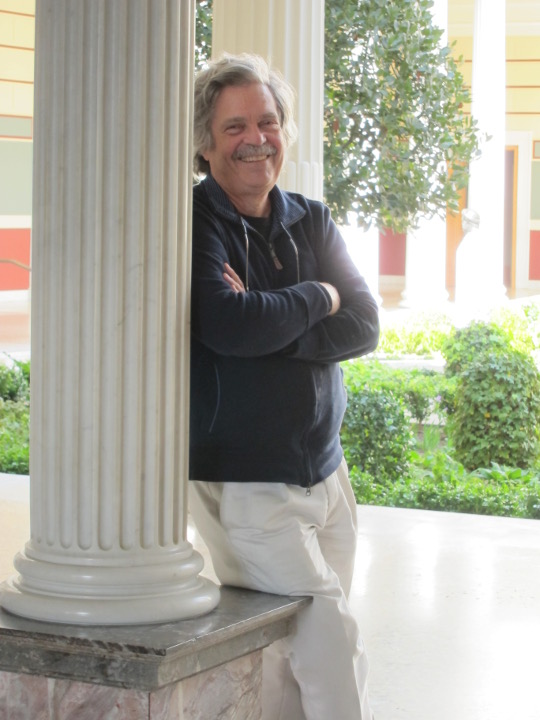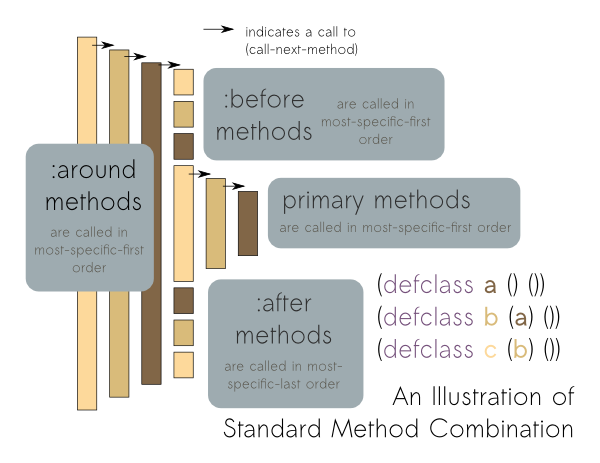|
The Art Of The Metaobject Protocol
''The Art of the Metaobject Protocol'' (AMOP) is a 1991 book by Gregor Kiczales, Jim des Rivieres, and Daniel G. Bobrow (all three working for Xerox PARC) on the subject of metaobject protocol. Overview The book contains an explanation of what a metaobject protocol is, why it is desirable, and the ''de facto'' standard for the metaobject protocol supported by many Common Lisp implementations as an extension of the Common Lisp Object System, or CLOS. A more complete and portable implementation of CLOS and the metaobject protocol, as defined in this book, was provided by Xerox PARC as Portable Common Loops. The book presents a simplified CLOS implementation for Common Lisp called "Closette", which for the sake of pedagogical brevity does not include some of the more complex or exotic CLOS features such as forward-referencing of superclasses, full class and method redefinitions, advanced user-defined method combinations, and complete integration of CLOS classes with Common Lisp's typ ... [...More Info...] [...Related Items...] OR: [Wikipedia] [Google] [Baidu] |
Gregor Kiczales
Gregor Kiczales is an American computer scientist. He is currently a full time professor of computer science at the University of British Columbia in Vancouver, British Columbia, Canada. He is best known for developing the concept of aspect-oriented programming, and the AspectJ extension to the Java programming language, both of which he designed while working at Xerox PARC. He is also one of the co-authors of the specification for the Common Lisp Object System, and is the author of the book ''The Art of the Metaobject Protocol'', along with Jim Des Rivières and Daniel G. Bobrow. Most of Kiczales' work throughout the years has been focused on allowing software engineers to create programs that look as much as possible like their design, to reduce complexity and make code maintenance easier, ultimately improving software quality. Career After pursuing undergraduate studies at MIT, Kiczales started his research career in 1980 at the MIT Lab for Computer Science, where he stay ... [...More Info...] [...Related Items...] OR: [Wikipedia] [Google] [Baidu] |
Class (computer Programming)
In object-oriented programming, a class is an extensible program-code-template for creating objects, providing initial values for state (member variables) and implementations of behavior (member functions or methods). In many languages, the class name is used as the name for the class (the template itself), the name for the default constructor of the class (a subroutine that creates objects), and as the type of objects generated by instantiating the class; these distinct concepts are easily conflated. Although, to the point of conflation, one could argue that is a feature inherent in a language because of its polymorphic nature and why these languages are so powerful, dynamic and adaptable for use compared to languages without polymorphism present. Thus they can model dynamic systems (i.e. the real world, machine learning, AI) more easily. When an object is created by a constructor of the class, the resulting object is called an instance of the class, and the member variable ... [...More Info...] [...Related Items...] OR: [Wikipedia] [Google] [Baidu] |
Georgia Institute Of Technology
The Georgia Institute of Technology, commonly referred to as Georgia Tech or, in the state of Georgia, as Tech or The Institute, is a public research university and institute of technology in Atlanta, Georgia. Established in 1885, it is part of the University System of Georgia and has satellite campuses in Savannah, Georgia; Metz, France; Shenzhen, China; and Singapore. The school was founded as the Georgia School of Technology as part of Reconstruction plans to build an industrial economy in the post-Civil War Southern United States. Initially, it offered only a degree in mechanical engineering. By 1901, its curriculum had expanded to include electrical, civil, and chemical engineering. In 1948, the school changed its name to reflect its evolution from a trade school to a larger and more capable technical institute and research university. Today, Georgia Tech is organized into six colleges and contains about 31 departments/units, with emphasis on science and technology. I ... [...More Info...] [...Related Items...] OR: [Wikipedia] [Google] [Baidu] |
Lisp (programming Language)
Lisp (historically LISP) is a family of programming languages with a long history and a distinctive, fully parenthesized prefix notation. Originally specified in 1960, Lisp is the second-oldest high-level programming language still in common use, after Fortran. Lisp has changed since its early days, and many dialects have existed over its history. Today, the best-known general-purpose Lisp dialects are Common Lisp, Scheme, Racket and Clojure. Lisp was originally created as a practical mathematical notation for computer programs, influenced by (though not originally derived from) the notation of Alonzo Church's lambda calculus. It quickly became a favored programming language for artificial intelligence (AI) research. As one of the earliest programming languages, Lisp pioneered many ideas in computer science, including tree data structures, automatic storage management, dynamic typing, conditionals, higher-order functions, recursion, the self-hosting compiler, and the read‚Ä ... [...More Info...] [...Related Items...] OR: [Wikipedia] [Google] [Baidu] |
Object-oriented Programming
Object-oriented programming (OOP) is a programming paradigm based on the concept of "objects", which can contain data and code. The data is in the form of fields (often known as attributes or ''properties''), and the code is in the form of procedures (often known as ''methods''). A common feature of objects is that procedures (or methods) are attached to them and can access and modify the object's data fields. In this brand of OOP, there is usually a special name such as or used to refer to the current object. In OOP, computer programs are designed by making them out of objects that interact with one another. OOP languages are diverse, but the most popular ones are class-based, meaning that objects are instances of classes, which also determine their types. Many of the most widely used programming languages (such as C++, Java, Python, etc.) are multi-paradigm and they support object-oriented programming to a greater or lesser degree, typically in combination with imper ... [...More Info...] [...Related Items...] OR: [Wikipedia] [Google] [Baidu] |
Alan Kay
Alan Curtis Kay (born May 17, 1940) published by the Association for Computing Machinery 2012 is an American computer scientist best known for his pioneering work on object-oriented programming and windowing graphical user interface (GUI) design. At Xerox PARC he led the design and development of the first modern windowed computer desktop interface. There he also led the development of the influential object-oriented programming language Smalltalk, both personally designing most of the early versions of the language and coining the term "object-oriented." He has been elected a Fellow of the American Academy of Arts and Sciences, the National Academy of Engineering, and the Royal Society of Arts. He received the Turing award in 2003. Kay is also a former professional jazz guitarist, composer, and theatrical designer. He also is an amateur classical pipe organist. Early life and work In an interview on education in America with the Davis Group Ltd., Kay said: Ori ... [...More Info...] [...Related Items...] OR: [Wikipedia] [Google] [Baidu] |
OOPSLA
OOPSLA (Object-Oriented Programming, Systems, Languages & Applications) is an annual ACM research conference. OOPSLA mainly takes place in the United States, while the sister conference of OOPSLA, ECOOP, is typically held in Europe. It is operated by the Special Interest Group for Programming Languages (SIGPLAN) group of the Association for Computing Machinery (ACM). OOPSLA is an annual conference covering topics related to object-oriented programming systems, languages and applications. Like other conferences, OOPSLA offers various tracks and many simultaneous sessions, and thus has a different meaning to different people. It is an academic conference, and draws doctoral students who present peer-reviewed papers. It also draws a number of non-academic attendees, many of whom present experience reports and conduct panels, workshops and tutorials. OOPSLA has been instrumental in helping object-oriented programming develop into a mainstream programming paradigm. It has also helpe ... [...More Info...] [...Related Items...] OR: [Wikipedia] [Google] [Baidu] |
Meta-circular Evaluator
In computing, a meta-circular evaluator (MCE) or meta-circular interpreter (MCI) is an interpreter which defines each feature of the interpreted language using a similar facility of the interpreter's host language. For example, interpreting a lambda application may be implemented using function application. Meta-circular evaluation is most prominent in the context of Lisp. A self-interpreter is a meta-circular interpreter where the interpreted language is nearly identical to the host language; the two terms are often used synonymously. History The dissertation of Corrado Böhm describes the design of a self-hosting compiler. Due to the difficulty of compiling higher-order functions, many languages were instead defined via interpreters, most prominently Lisp. The term itself was coined by John C. Reynolds, and popularized through its use in the book ''Structure and Interpretation of Computer Programs''. Self-interpreters A self-interpreter is a meta-circular interpreter wher ... [...More Info...] [...Related Items...] OR: [Wikipedia] [Google] [Baidu] |
Type System
In computer programming, a type system is a logical system comprising a set of rules that assigns a property called a type to every "term" (a word, phrase, or other set of symbols). Usually the terms are various constructs of a computer program, such as variables, expressions, functions, or modules. A type system dictates the operations that can be performed on a term. For variables, the type system determines the allowed values of that term. Type systems formalize and enforce the otherwise implicit categories the programmer uses for algebraic data types, data structures, or other components (e.g. "string", "array of float", "function returning boolean"). Type systems are often specified as part of programming languages and built into interpreters and compilers, although the type system of a language can be extended by optional tools that perform added checks using the language's original type syntax and grammar. The main purpose of a type system in a programming language ... [...More Info...] [...Related Items...] OR: [Wikipedia] [Google] [Baidu] |
CLOS (CLOS)
{{disambiguation ...
Clos may refer to: People * Clos (surname) Other uses * CLOS, Command line-of-sight, a method of guiding a missile to its intended target * Clos network, a kind of multistage switching network * Clos (vineyard), a walled vineyard; used in France, Germany and California * an alternative spelling of ''close'' in the name of a Cul-de-sac * Common Lisp Object System The Common Lisp Object System (CLOS) is the facility for object-oriented programming which is part of ANSI Common Lisp. CLOS is a powerful dynamic object system which differs radically from the OOP facilities found in more static languages such ... [...More Info...] [...Related Items...] OR: [Wikipedia] [Google] [Baidu] |
Jim Des Rivieres
Jim or JIM may refer to: * Jim (given name), a given name * Jim, a diminutive form of the given name James * Jim, a short form of the given name Jimmy * OPCW-UN Joint Investigative Mechanism * ''Jim'' (comics), a series by Jim Woodring * ''Jim'' (album), by soul artist Jamie Lidell * Jim (''Huckleberry Finn''), a character in Mark Twain's novel * Jim (TV channel), in Finland * JIM (Flemish TV channel) * JIM suit, for atmospheric diving * Jim River, in North and South Dakota, United States * Jim, the nickname of Yelkanum Seclamatan (died April 1911), Native American chief * ''Journal of Internal Medicine'' * Juan Ignacio Mart√≠nez (born 1964), Spanish footballer, commonly known as JIM * Jim (horse), milk wagon horse used to produce serum containing diphtheria antitoxin * "Jim" (song), a 1941 song. * JIM, Jiangxi Isuzu Motors, a joint venture between Isuzu and Jiangling Motors Corporation Group (JMCG). * Jim (Medal of Honor recipient) See also * * Gym * Jjim * «¶ńęm * Jam ... [...More Info...] [...Related Items...] OR: [Wikipedia] [Google] [Baidu] |
Common Lisp Object System
The Common Lisp Object System (CLOS) is the facility for object-oriented programming which is part of ANSI Common Lisp. CLOS is a powerful dynamic object system which differs radically from the OOP facilities found in more static languages such as C++ or Java. CLOS was inspired by earlier Lisp object systems such as MIT Flavors and CommonLoops, although it is more general than either. Originally proposed as an add-on, CLOS was adopted as part of the ANSI standard for Common Lisp and has been adapted into other Lisp dialects such as EuLisp or Emacs Lisp. Features The basic building blocks of CLOS are methods, classes, instances of those classes, and generic functions. CLOS provides macros to define those: defclass, defmethod, and defgeneric. Instances are created with the method make-instance. Classes can have multiple superclasses, a list of slots (member variables in C++/Java parlance) and a special metaclass. Slots can be allocated by class (all instances of a class share th ... [...More Info...] [...Related Items...] OR: [Wikipedia] [Google] [Baidu] |






